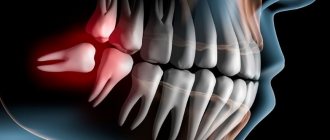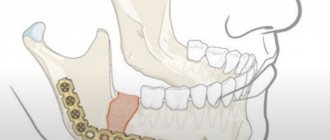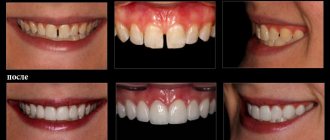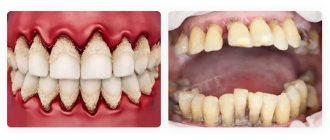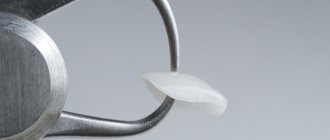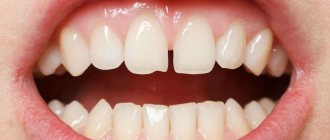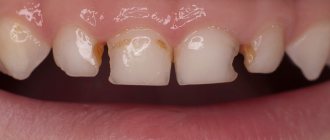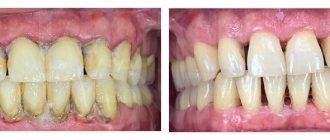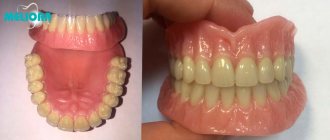Splinting teeth for periodontitis and periodontal disease is an effective treatment method aimed at strengthening teeth and distributing the chewing load. The essence of the process is that the dentition, together with a loose tooth, is connected into a single structure, using dentures or special threads, which makes it possible to restore a weakened tooth and provide an even load when chewing.
When baby teeth become loose in children, there is nothing to worry about, because a new one will definitely grow in place of the old tooth. However, when healthy teeth begin to loosen, this is a serious signal that indicates the development of a pathological process in the body. The causes of this condition must be identified and treatment must be started immediately.
Make an appointment with a therapist by phone+7(985)532-21-01
The main causes of loose teeth
Loose teeth in any case is a serious symptom that indicates the development of a pathological process in the body. Experts have identified several main reasons affecting tooth loosening:
- periodontitis;
- periodontal disease;
- gingivitis;
- congenital gum pathologies;
- jaw injuries;
- unbalanced diet;
- tumor formations in the jaw and gums.
The most common cause of this condition is periodontitis, which is inflammation of the periodontal tissue. In this case, the root is exposed and the teeth begin to loosen. Periodontal disease can also often cause loosening; its result is a lack of strength between the tooth and the surrounding tissues. In any case, when one of these diseases is diagnosed, careful and long-term treatment is necessary to help fix the teeth.
On a note! Sometimes a similar condition can be caused by the absence of neighboring teeth when dental implantation and prosthetics were not carried out in time. In this situation, doctors also prescribe splinting and restoration of the lost unit.
Indications for splinting teeth
Experts prescribe splinting for the following diagnosis:
- periodontal disease, especially in advanced form;
- deep gum pockets caused by periodontitis;
- jaw injuries resulting in loosening of teeth;
- certain congenital pathologies;
- constant bleeding gums;
- deformation of teeth under the influence of external factors.
This technique is also used during orthodontic treatment at the final stage; splints are applied after adjustment with briquettes in order to fix the established position.
Contraindications
There are few contraindications for performing the procedure. An absolute contraindication is an allergy to the materials used. Relative - increased sensitivity of teeth, severe inflammation of the gums, purulent processes inside the gum pockets. These factors must be eliminated before splinting. If your oral hygiene is poor, installing a splint may simply be useless.
Splinting teeth price
The cost of the procedure depends on the chosen technique and materials. The cheapest option is to use steel crowns. Stabilizing anterior teeth with fiberglass tape costs more, splinting molars and premolars costs less.
The most expensive design is the clasp prosthesis. Often, immediately before splinting, the patient needs to undergo additional treatment, for example, for increased tooth sensitivity, remineralization. This can also significantly affect the cost of the entire procedure.
The final price for dental splinting can be announced by the doctor only after the treatment plan has been approved.
Teeth splinting methods
There are several basic techniques that are selected depending on such basic factors as the condition of the oral cavity, the advanced stage of the disease, the stage of loosening, etc. Splinting can be permanent or temporary. Temporary splints are installed for a short period, for example, for injuries, and permanent splints are used for serious pathological processes that require long-term treatment.
Also, splinting teeth for periodontitis can be removable or non-removable, each of them has individual indications. As a rule, the removable method is used during fractures or bruises, using special fiberglass or armid fiber threads. Fixed is prescribed for severe mobility of the dentition using especially durable materials that ensure reliable adhesion. These are mainly crowns, dentures, threads, durable fiberglass.
“Some patients, when diagnosed with periodontal disease or periodontitis, neglect to install splints, and this is a mistake. After all, their use prolongs the life of the dentition and maintains health. In the case of an advanced form, these measures are temporary, but without this you can quickly lose teeth.”
Splinting mobile teeth with fiberglass
Splinting using fiberglass is considered the most common and is carried out using several methods.
- In preparation for splinting, ultrasonic teeth cleaning is performed. The specialist then creates a notch on the inner surface, lays the thread and secures it with a composite. The technology is considered the most reliable and durable, suitable for long-term therapy.
- The second method is that the tire is laid superficially on the inside of the row. This measure is temporary and is used for injuries or orthodontic therapy.
The first method is most often prescribed for the initial stage of periodontal disease or periodontitis, when the loosening is insignificant. When the process is started, the technique may turn out to be ineffective and you can lose teeth, despite the presence of fiberglass.
Areas of application
In practice, GlassSpan is used if necessary:
- perform periodontal strengthening (splinting) of loose lateral and frontal dental elements;
- provide rapid palliative treatment;
- bring diseased and reimplanted units back to normal;
- temporarily strengthen bridge-type prostheses;
- post-orthodontic preservation;
- form a long-term or temporary connecting bridge structure;
- quickly replace a removed or fallen out tooth element;
- perform adhesive splinting against the background of pathologies of periodontal tissues;
- carry out microprosthetics;
- restore the tooth using an intracanal pin.
Cable splinting of teeth
The technique is completely similar to the previous one, only instead of fiber, specialists use aramid thread. This is a reliable polymer material, the advantage of which is the fact that it does not cause a chemical reaction upon contact with food and saliva, thereby not creating an unpleasant bite in the mouth.
This method not only restores chewing function, but is also considered quite aesthetic. Cable splinting allows you to securely fix the teeth and evenly distribute the load on them. However, in addition to the advantages, there is a significant drawback. If the inflammatory process is advanced, the use of such a procedure may be ineffective.
Interesting! All materials used to install splints are light and safe, do not impede dental care, and have the color of natural crowns.
Technical qualities
Dentists who use GlassSpan in their practice claim that this system is easier to work with than other analog ones, since the product does not become contaminated.
Many of these materials require pre-treatment or impregnation with special resins and compounds before starting work; they cannot be touched by gloves without introducing dirt. This circumstance complicates the process of restoring the tooth and attempting to fix the splint in the mouth.
The splinting tape of the system is thin and quite flexible , while other reinforcing materials are much thicker. It can be cut with any scissors, which cannot be done with material from other manufacturers. They can only be cut with special scissors.
The tape contains ceramic fibers, but not plastic . Ceramics are more stable in parameters, do not absorb moisture, and do not require additional processing than plastic. The transparency of ceramic fibers is more aesthetically pleasing and does not wear out.
If, when polishing or adjusting a restoration, plastic fibers are accidentally exposed to temperature, the process of fusion will begin. The material will quickly become contaminated and the doctor will have to redo the work.
This does not happen with the material of the GlassSpan system - you can easily polish it, because... there is no reaction to temperature changes.
The cord is also different. This is the only type of fiber that has a round braided shape - twisted into a hollow rope. It is more practical and convenient for performing splinting, artificial extension of columns and strengthening of prostheses. Typically, ropes are inflated with a flowable composite or layer-by-layer material.
The GlassSpan system also stands out for its patented surface treatment method - it has ceramic etched fiber, which guarantees complete final adhesion to the composite.
Some other types of fibers must first be coated with resin without undergoing a proprietary treatment, which reduces bond strength.
Clasp prosthesis
This method refers to removable splinting. The clasp prosthesis is represented by a structure that is made in the form of a metal arch with claw-shaped processes and multi-link clasps that fix each tooth individually. The prosthesis also has crowns under which the supporting teeth are installed, this helps protect patients from stress. The specified splinting design is selected for each person individually, based on the condition of the dentition, bite and other related factors.
Among the main advantages are:
- reliable fixation;
- proper load distribution;
- there is no need to grind crowns;
- comfort and convenience compared to many designs;
- durability.
There are also minor drawbacks. Some people feel discomfort in the mouth for the first time after installing dentures; when there is a need to install clasps on the front row, metal crowns do not look very aesthetically pleasing. This type of splinting is also not suitable for those who are extremely missing teeth.
Important! The duration of wearing the clasp construction exceeds 7 years, but experts advise using it as temporary, since there is a risk of bone tissue atrophy. In this case, if it is not possible to restore a loose tooth, it is best to remove it and replace it with a high-quality implant.
Features of use
Due to the fact that the ceramic system has a lot of qualities and characteristics useful for dental procedures, it is widely used by doctors in their work.
Splinting
This is the main area of application of GlassSpan. The technique of performing the procedure completely depends on the group affiliation of the teeth that are to be strengthened.
If you stabilize the anterior units on any of the jaws, then splinting begins with the formation of a small groove on the inner tooth surface. Afterwards, a tape will be placed in it, which will cover not only the moving elements, but also the stable ones.
Such a single block promotes uniform redistribution of the chewing load on the front teeth.
Fixation of the system from the oral cavity is done in order to preserve the overall aesthetics of the smile.
When strengthening the posterior and lateral elements, a groove is drilled along their chewing surface.
The void remaining after placing the tape is filled with composite material , which is then illuminated with a light curing lamp.
Microprosthetics
This is a good opportunity to qualitatively, aesthetically and quickly recreate the integrity of a destroyed tooth and return it to full functionality, while preserving the neighboring units intact (without resorting to grinding them down).
The system makes it possible to restore 1-2 units in one visit:
- the reinforcing beam is made of GlassSpan cord;
- attached to healthy neighboring elements using an adhesive mass.
- The dentist first makes small incisions with a depth of up to 2 mm.
- The ends of the beam are inserted into the recesses.
Immediately after fixation, the doctor begins to form the crown part of the future tooth with a composite, the shade of which is closest to the natural color of the “native” teeth.
The overall restoration time is significantly reduced by eliminating the need for a metal base.
Microprosthetics using this system is offered to patients with healthy supporting units, i.e. without carious cavities and other defects, as well as those who are allergic to metal.
Important! Microprosthetics with the GlassSpan system allows for complete restoration of teeth only in the anterior part of the jaws.
Manufacturing of adhesive bridges
If necessary, the material of the system is used to form the base of the future prosthesis by layer-by-layer laying of tape or cords.
This technology is recognized by dentists as the most progressive and gentle in relation to the teeth adjacent to the defect site.
The procedure consists of the following steps:
- Small notches are made on the supporting teeth.
- The beam is fixed in them.
- Creation based on an artificial tooth made of composite material.
All actions take place directly in the patient’s mouth in one visit , provided there are no pathologies of the supporting units.
Regardless of the chosen method of teeth restoration with the GlassSpan system, the dentist must observe the following rules during work:
- Carefully remove the material from the capsule.
- To prevent foreign impurities from getting on it, cover the remaining part with a Teflon lid.
- To prevent tangling, do not trim the tape/cord until it has been covered with the composite compound.
- When preparing a strip of the required length, it is necessary to discard 0.5 cm of material from its beginning so that the protective coating does not get into the recess.
Composition and properties of the drug Septopak, detailed instructions for use.
In this publication, read about the advantages and design of disposable carpule syringes for anesthesia.
Follow the link https://www.vash-dentist.ru/lechenie/zubyi/lentyi-ribbond-v-stomatologii.html if you are interested in reviews about the Ribbond tape.
Pros and cons of the splinting technique
Of course, the use of this technique makes it possible to regenerate damaged teeth, helps the body recover and, if necessary, carry out further treatment. Moreover, during the development of periodontitis and periodontal disease, splinting helps distribute the load as needed, increasing it on healthy teeth and decreasing it on damaged teeth. This makes it possible to avoid injury to the gums and quickly restore them.
In addition to significant advantages, splinting also has some disadvantages. Such therapy does not bring results when the disease takes on an advanced form and the inflammatory process progresses; in this case, splints may be ineffective and fall out along with the teeth. Also, patients who do not pay the necessary attention to oral hygiene can increase their problems and acquire pathologies such as pulpitis or the development of caries. If the procedure was performed by an inexperienced specialist, then discomfort for the patient may occur.
Even if the procedure has some disadvantages, this is not a reason not to use the method. To do this, you need to go to a good clinic and see a professional who can carry out all the manipulations clearly and competently. Also, while wearing splints, you should constantly monitor your dental hygiene and thoroughly clean them.
Advantages of technology
You should agree to the splinting procedure because it:
- reliable prevention of tooth loss;
- painlessness and efficiency;
- no likelihood of developing caries;
- aesthetics;
- stopping the process of deformation of the bones of the jaw apparatus;
- eliminating changes in the location of teeth and the distance between them;
- minimal trauma (no turning, depulpation);
- safety, harmlessness of materials;
- easy oral care after treatment.
Cost of teeth splinting
Splinting of parods. teeth (3–7 teeth) …………………………………………….. 10,000 rub.
The cost of splinting is determined by several factors. First of all, it depends on the condition of the patient’s oral cavity. If the patient has additional problems that require cleaning or treatment, then naturally such therapy will also be included in the cost of the service. The cost will also depend on the chosen method, which is determined individually for each.
If you are faced with a problem such as dental mobility, you need to contact a specialist as soon as possible and use the splinting procedure. Timely help from professionals will help preserve teeth, strengthen gums and restore chewing function.
Make an appointment with a therapist by phone+7(985)532-21-01
Open and closed curettage of periodontal pockets
The roots of the teeth are exposed - what to do and how to treat them
Laser gingivectomy in the area of one tooth
Catarrhal and hypertrophic gingivitis symptoms and treatment in adults
Laser gingivotomy - surgical treatment of complex forms of periodontitis
Splinting teeth for periodontitis with fiberglass and tape
Release form
Packaging: glass capsule.
The set includes:
- ceramic tape (GlasSpan Tape) - length 27cm (3 by 9cm), width 2.00mm;
- small cord (Rope Small) - length 27cm (3 by 9cm), width 1.00mm;
- medium cord (Rope Medium) - length 27cm (3 by 9cm), width 1.50mm;
- large cord (Rope Large) - length 27cm (3 by 9cm), width 2.00mm.
One set contains 4 glass capsules.
